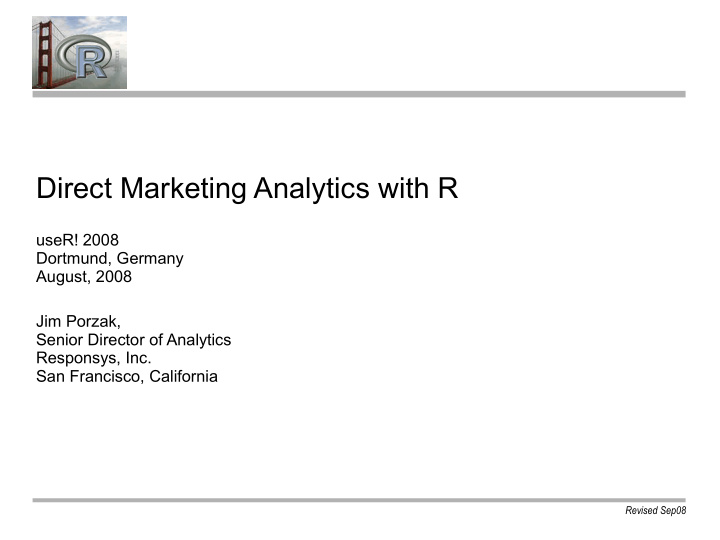



Direct Marketing Analytics with R useR! 2008 Dortmund, Germany August, 2008 Jim Porzak, Senior Director of Analytics Responsys, Inc. San Francisco, California Revised Sep08
Outline ● Introduction – What is Direct Marketing (DM)? – How does “analytics” play a role? – What's Special About DM data & analytics? ● DM data requirements -> Class Structure ● Basic DM Metrics ● Testing ● Segmentation ● Modeling ● Directions & Questions ● (Appendix with resources & links) 09/03/08 useR! 2008 -Porzak - DMA 2
Introduction 09/03/08 useR! 2008 -Porzak - DMA 3
What is DM? ● Also know as “direct response marketing.” ● Characteristics: – Directed at targeted individuals or demographic – Response is asked for and expected – Tracking of responses back to source – Evaluated by counts and value [€, £, $, ...] – Testing of alternate elements is implicit in DM ● Elements (in order of importance): 1. List 2. Offer 3. Creative 09/03/08 useR! 2008 -Porzak - DMA 4
Channels used in DM Classical Internet ● Individual ● Individual – Email – Direct Mail ● Demographic ● Demographic – Banner – Advertisement – Search – TV or Radio ● Paid – Billboard ● Free – Insert Remember, all of above ask for a response that is traceable back to source! 09/03/08 useR! 2008 -Porzak - DMA 5
Use Analytics to Answer these Questions ● Directed to whom? – Predicting responses ● Which of list, or part of list? ● When to send? – Segmenting population – ● To use best offer, creative, & channel ● Evaluated with accepted metrics – Open definitions are important here. – Use confidence intervals ● Testing to improve next time around. – Show significance of results 09/03/08 useR! 2008 -Porzak - DMA 6
So What's So Special? ● Statistically speaking? – Not much... – But remember the nature of DM problems: ● Huge N (typically 10 4 to 10 7 ) ● Small proportions (often 3% to 0.05% for direct or email) ● The audience! – The corporate world – DMers themselves ● The Data Structure – Levels of granularity – “Campaign” hierarchies drives testing 09/03/08 useR! 2008 -Porzak - DMA 7
“It's the structure, stupid!” 09/03/08 useR! 2008 -Porzak - DMA 8
The DM Process (Individual) Postal Mail Email ● Outbound ● Outbound – Mail a “piece” – Send a “message” ● Tagged? ● Tagged? ● Inbound ● Inbound – Recipient responds – ISP ● Return mail ● Bounce ● Opt-out ● Calling 800# – Recipient ● Visits ● Open – Web ● Click – Physical location ● (Request or Buy) ● Opt-out 09/03/08 useR! 2008 -Porzak - DMA 9
Data Elements ● Details – The “List” (perhaps with additional data) – Send Events – Response Events ● Summaries – Response counts & rates (total & unique) – Simple “cell-level” metrics ● Campaign Meta-data – Costs and Values – Time window – Batch or Triggered – 09/03/08 useR! 2008 -Porzak - DMA 10
Class & Method Challenges ● Detail & Summary classes. ~ straightforward ● Campaign wise meta-data. ~ straightforward ● Campaign elements & relations. harder! – summary, print & plot should be able to understand a group of campaigns and elements within a campaign. ● Leverage arules? From package vignette: arules.pdf 09/03/08 useR! 2008 -Porzak - DMA 11
DMA Modules 09/03/08 useR! 2008 -Porzak - DMA 12
Direct Marketing Metrics ● Direct Mail – Response counts & rate – Cost per response (sale, lead, ...) ● Email – all above, plus email specific metrics ● Opt-out, bounce, open, click counts & rates ● Add unique opens, clicks, responses ● General – Campaign ROI – List growth (opt-ins / -outs per time period) – List fatigue 09/03/08 useR! 2008 -Porzak - DMA 13
DM Testing ● Simple 2-way: A/B, Control/Test ● Multiple test against control: A/BCD... ● True MVT Goal is appropriate analysis done based on campaign meta-data. 09/03/08 useR! 2008 -Porzak - DMA 14
Example A/BC Test 09/03/08 useR! 2008 -Porzak - DMA 15
Segmentation for Targeting ● Behavior based – Purchases – Usage ● Attitudinal – Preference / Interest Survey 09/03/08 useR! 2008 -Porzak - DMA 16
Purchase Behavior Example 09/03/08 useR! 2008 -Porzak - DMA 17
Purchase Behavior Categories For executive presentations, we re-draw the segment cells in this way: 09/03/08 useR! 2008 -Porzak - DMA 18
Modeling for List Optimization ● Model full list to select those recipients with highest expected response to offer ● Methods include logistic regression and machine learning tools like random forest. ● Supply “model validation” curve (ROC) so marketer can pick “depth of file” to use based on economics of the offer 09/03/08 useR! 2008 -Porzak - DMA 19
Response Prediction Example 09/03/08 useR! 2008 -Porzak - DMA 20
Future Directions ● Finalize class structure – Need to work through more use cases ● Feel free to send examples! – Sketch method dependencies ● Roadmap – Independent batch campaigns – 2-way & n-way against control – Triggered campaigns – True MVT – Segmentation – Response Modeling ● On R-Forge: https://r-forge.r-project.org/projects/dma/ – Collaborators welcome! 09/03/08 useR! 2008 -Porzak - DMA 21
Thanks! 09/03/08 useR! 2008 -Porzak - DMA 22
Appendix 09/03/08 useR! 2008 -Porzak - DMA 23
Links & References Books ● Metrics – ● Davis, Measuring Marketing – 103 Key Metrics Every Marketer Needs , Wiley, 2007 ● Farris, Bendle, Pfeifer & Reibstein, Marketing Metrics – 50+ Metrics Every Executive Should Master , Wharton, 3 rd printing, 2006. Marketing – ● Libey & Pickering, RFM & Beyond , MeritDirect Press, 2005. ● Alan Tapp, Principles of Direct and Database Marketing , 3 rd Edition, Pearson, 2005. ● A. M. Hughes, Strategic Database Marketing, 3 rd Edition , McGraw-Hill, 2006. Links ● Related Talks on www.porzak.com/JimArchive/ – dma on R-Forge https://r-forge.r-project.org/projects/dma/ – Responsys.com Resource Center – Direct Marketing Association International Resources – Email Experience Council Home – EmailLabs: Glossary, Benchmark Data – use R Group of San Francisco Bay Area http://ia.meetup.com/67/ – 09/03/08 useR! 2008 -Porzak - DMA 24
Recommend
More recommend